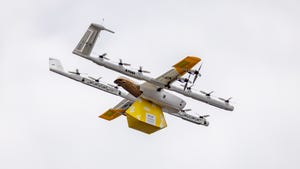
Expect Smoother Drone Delivery With Wing's Autoloader - CNET
Wing, the drone delivery subsidiary from Google parent company Alphabet, has shown publicly for the first time the “autoloader” station it expects will make it significantly easier for retailers to send products through the air to customers.
The autoloader, announced in March and set to be deployed later this year, is a Y-shaped stand that easily fits in a parking space. A company employee hangs a delivery box on a pair of hooks on the autoloader then returns to work. There’s no need to wait for the drone to arrive, because it can snag the package on its own by lowering a yellow hook to the autoloader station.

Adding the autoloader may seem like a minor change, but it paves the way for a potentially massive expansion of drone delivery. Instead of operating isolated base stations, Wing envisions a fleet of drones autonomously dispatched across a network of delivery and charging stations, hopping from one destination to another with a minimum of human intervention. Inexpensive autoloaders make it easier to bring new retailers into the network.
Drone delivery today remains limited by regulators who limit its expansion to a few pockets, but the regulations are maturing along with the technology. Expect millions of us to be within drone delivery range this year from Wing and rival drone delivery efforts from Zipline, Amazon, Drone Express, Matternet, DroneUp, Manna and others.
Wing demonstrated its autoloader technology in a company parking lot at offices in Palo Alto, California, flying packages to a nearby courtyard. It took no special measures to avoid people, trees and cars other than blocking off three parking spots with traffic cones, a sign that Chief Executive Adam Woodworth said shows how mature operations have become.
“We are at the point in this journey where I think that this is a thing that’s going to happen,” Woodworth said. Wing has made more than 340,000 drone deliveries so far with operations in Australia, Finland, Virginia and Texas.
The autoloader has no computer controls or moving parts, but it’s still pretty sophisticated. The two upward pointing poles help guide the drone’s hook, dangling from a string below the hovering drone, to a narrow slot that aligns the hook properly to latch onto the waterproof, recyclable package.
The slot, package and drone hook are all designed to work together. For example, the hook will grab the package only once it’s pushed through the hole on the package. Its round bottom won’t bump back in to regrab it after release.
“It’ll save a lot of time for the user. Instead of going to the store and picking something up, you’re staying at home and waiting for the drone to deliver it to your doorstep,” said Wing marketing chief Jonathan Bass. “For a worker, they can essentially place the package on the auto letter, go back inside and continue working. We think it will save a lot of time.”
The drones, made chiefly of foam, weigh 11 pounds each and can carry a payload up to 3.3 pounds.
“We do expect to introduce aircraft that can deliver larger payloads and some smaller [aircraft] that might be longer range,” Bass said.
Today, Wing’s drones have a range of 6 miles, though bing part of a Wing delivery network, with a mesh of destinations, will extend that since Wing can offer wireless charging pads in more locations.
Will we someday see delivery drones blackening the skies? Not likely, Woodworth believes. Even with current operations launching 1,000 flights a day, which can mean one every 30 seconds or so, drones are unusual.
“The sky is really big,” Woodworth said. “Even at full scale, you’re not going to look up and see tons of airplanes.”

